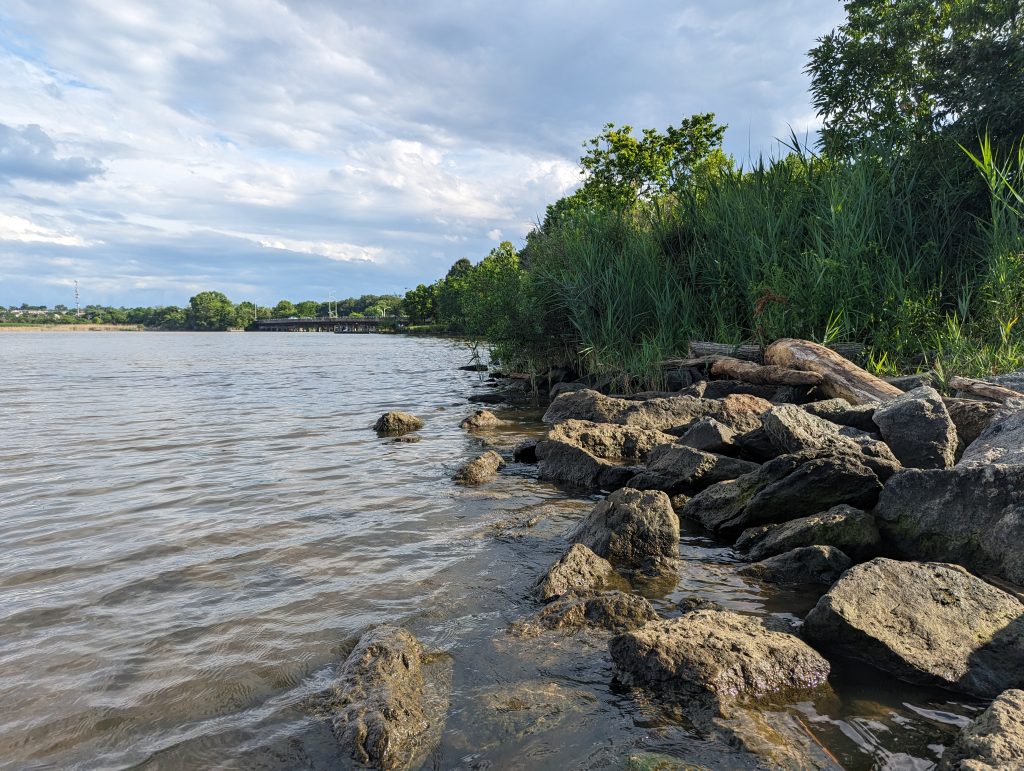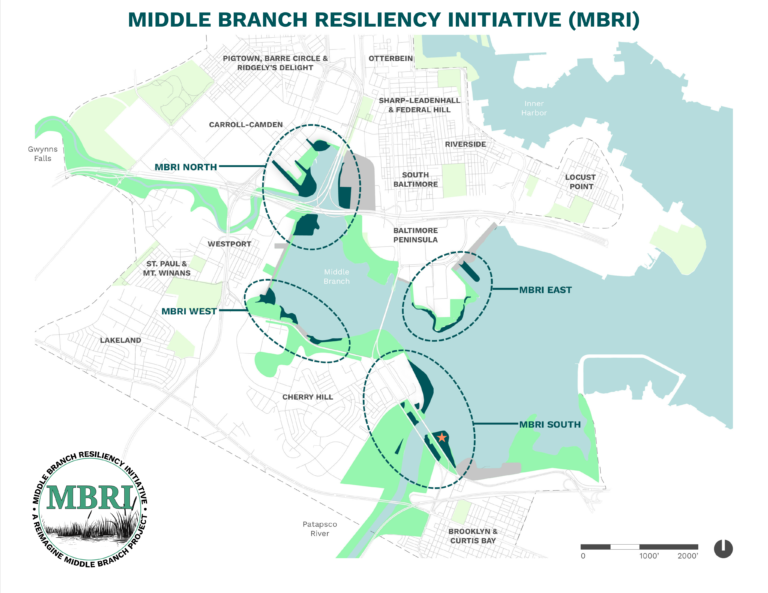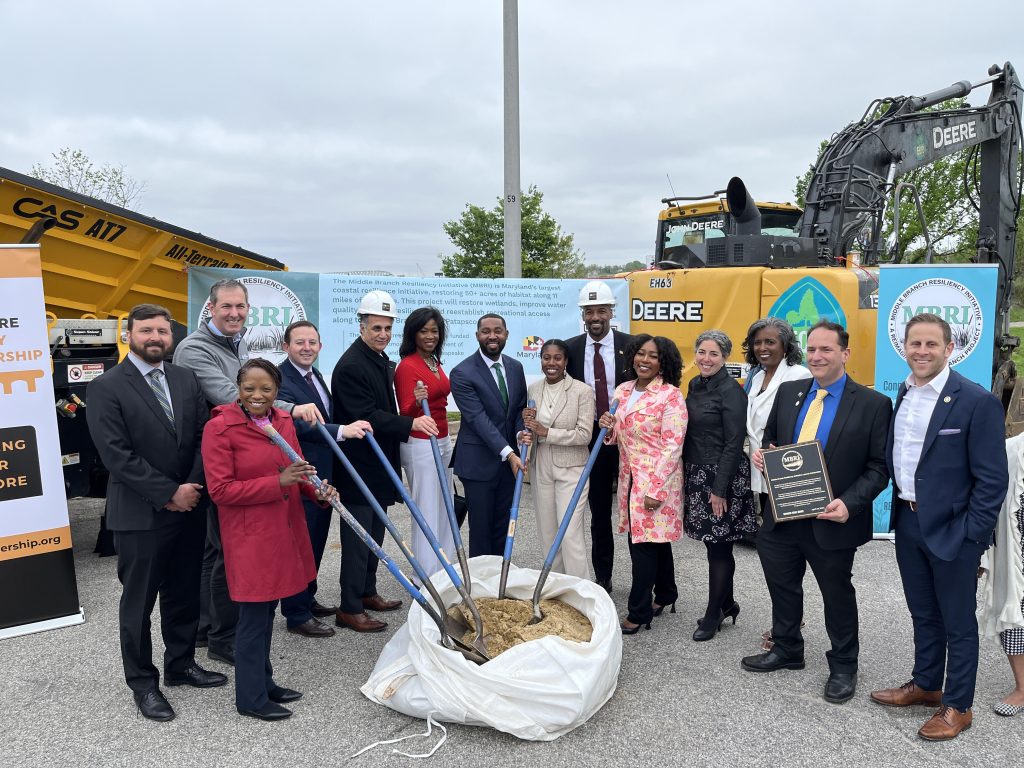Baltimore Project Brings Together Environmental Resilience and Community Development
The Middle Branch Resiliency Initiative could be a model for urban and community-led restoration

The Middle Branch area on the shore of the Patapsco River will be the site of the first phase of a large-scale restoration project. Photo by Joe Zimmermann
Located in the shadow of a Baltimore City hospital, within earshot of the highway, a stretch of waterfront along the Patapsco River may not appear to be a likely place for a living shoreline.
But a community-led environmental partnership is transforming this area, the Hanover Street Wetlands, as the first step in an ambitious initiative for habitat restoration, coastal resilience, community development, and environmental justice.
“It’s right in our backyard,” Peggy Jackson-Jobe, a 49-year resident of the adjacent Cherry Hill neighborhood and the chair of the Cherry Hill Community Coalition. “It gives the residents a beautiful place to go and to be a part of. And it’s great to know we had a hand in what’s evolving right now.”
The Middle Branch Resiliency Initiative is the largest planned coastal resilience initiative in Maryland, aiming to restore more than 50 acres of habitat and 11 miles of shoreline. Hanover Street Wetlands, the first phase of the project, is anticipated to be completed in 2025.
“This project is the absolutely perfect example of what we are looking to achieve—it will provide better water quality, improved protection for our communities, and build habitat,” said Maryland Department of Natural Resources Secretary Josh Kurtz. “All of those pieces coming together is exactly what we need to see across the region, especially in urban areas such as Baltimore.”
The initiative is part of Reimagine Middle Branch, an effort to transform the Middle Branch area of South Baltimore into the city’s “next great waterfront,” according to the South Baltimore Gateway Partnership, the organization that manages the project.
In 2015, after the opening of the Horseshoe Baltimore Casino, the city adopted the South Baltimore Gateway Master Plan to improve neighborhoods near the casino. Shortly after, Baltimore established the South Baltimore Gateway Partnership to oversee the master plan. It acts as the steward of funding generated by the video lottery terminals, directing it into nearby communities through various programs and projects, including the Middle Branch Resiliency Initiative.

Map of proposed wetland restorations for the Middle Branch Resiliency Initiative. The Hanover Street Wetlands are including in MBRI South. Via the South Baltimore Gateway Partnership
The Hanover Street Wetlands will include an intertidal wetland meant to provide a habitat for native species while also preventing flooding and shoreline erosion. It is the first of several planned initiative sites, many of which will incorporate significant public access improvements such as boardwalks, fishing piers, and trails for walking and biking.
This combination of ecological and community benefits runs through the whole project, said Samantha Rose, restoration manager with the South Baltimore Gateway Partnership.
“What I’m so excited about is that the Middle Branch Resiliency Initiative is an opportunity to invest in environmental justice and meet multiple goals simultaneously,” Rose said. “We’re not only improving the ecosystem and the water quality, we are improving quality of life in the area of South Baltimore.”
The initiative has now garnered nearly $67 million in funding from federal, state, and local government groups, including $3.5 million in seed funding from Maryland’s Chesapeake and Atlantic Coastal Bays Trust Fund, which is managed by Maryland’s Department of Natural Resources.
Dana Reiss, a DNR senior program director who manages the Trust Fund, said the initiative is unique as an urban wetland project, especially in a tidal area.
“This project acts as a natural filter in an urban setting, which is quite rare,” Reiss said. “Urban areas often lack these natural filters, so this initiative provides significant habitat value, nutrient uptake, and sediment reduction. Wetlands are also a great defense against storms, acting as a sponge to mitigate storm surges.”
She said the initiative could be a template for other urban watersheds and similar restoration projects built around community involvement.
Maggie Cavey, a DNR natural resource planner, said she’s excited by the initiative’s potential to use dredge material, which is being explored as a sustainable, local material source for future phases of the project. Dredge material is the sediment removed from navigation channels and docks—a common byproduct in a port like Baltimore.
Maryland law requires dredge material from the Baltimore harbor to be reused in the harbor area, and Cavey said it can be viewed as a renewable resource for coastal restoration.
“This project not only serves as an excellent demonstration of effective reuse but also highlights the benefits of utilizing dredged material right here in the harbor,” Cavey said.

State and local officials and organizational partners break ground at the Hanover Street Wetlands. Photo by A.J. Metcalf, Maryland Department of Natural Resources.
The initiative also involves the removal of invasive plants and the planting of native species, Rose said. There’s a plan for a native plant nursery, which Rose said will bring in the community for both training and employment opportunities as well as keeping community members involved in the ongoing management of the restored area.
“We’re looking at how the community can be involved in the long-term stewardship of these spaces,” Rose said. “And how this project can feed into workforce development and job opportunities that can uplift and benefit the community at large.”
Once it’s complete, the restored Middle Branch area will help reconnect communities with each other—bridging neighborhoods like Cherry Hill and Brooklyn that “have been divided by the industrial legacy and segregation and disinvestment,” Rose said.
And, with parks and a fishing pier, it will also help connect the area to the Patapsco River, which, though it borders the community, doesn’t currently facilitate much public access.
Jackson-Jobe said she’s glad the community has been involved from the beginning, from focus group meetings on Zoom in the early pandemic to community town halls. The initiative is a way for the community to be a part of the positive changes they want to bring to their neighborhoods, she said.
“I think it’s highly important for everybody who wants to use it to take pride in it and to preserve it,” Jackson-Jobe said. “We want to make sure that whatever it is we do is for the benefit of everybody.”
By Joe Zimmermann, science writer with the Maryland Department of Natural Resources.

 1-888-373-7888
1-888-373-7888 233733
233733